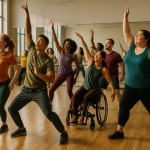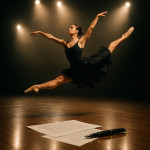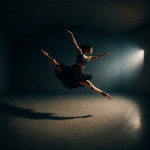Self-tape standards 2025: video specs that boost dancer callbacks worldwide
In 2025, casting directors view hundreds of dance self-tapes every week. Tiny technical flaws—muddy audio, blown-out highlights, shaky framing—can push an otherwise brilliant performer to the “no” pile. This guide walks you through the video specifications, workflow habits and file-delivery tricks that reliably lift callback rates for dancers on every continent.
Why 2025 self-tape standards matter
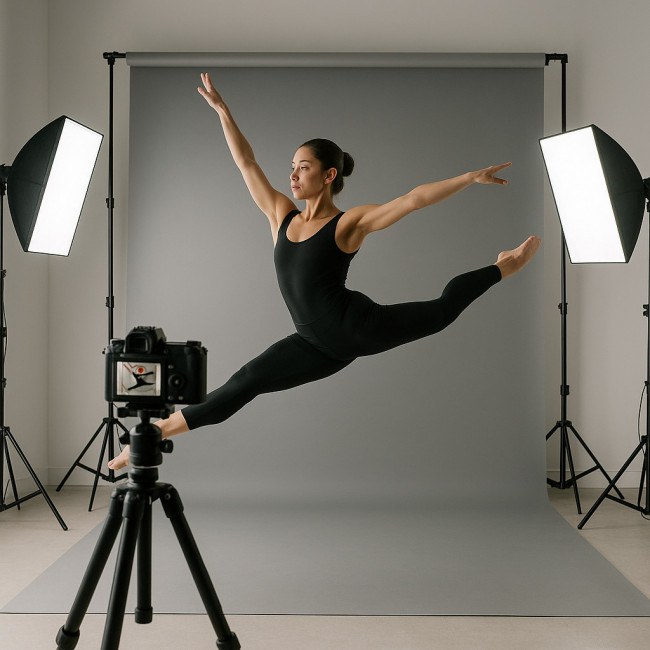
Streaming platforms, 8K screens and AI-assisted sorting tools have upgraded recruiter expectations. Agencies now preload auditions into software that scores lighting balance, audio peaks and aspect ratio before a human even presses play. Meeting—or exceeding—the baseline tech criteria keeps you in the running long enough for your artistry to shine.
Core video specs recruiters expect
Resolution & bitrate
Shoot at minimum 1080p (Full HD) with a bitrate of 15 Mbps or higher. Many studios now prefer 4K at 35 Mbps because it lets them crop in without losing clarity. Anything below 720p is usually auto-flagged for rejection in casting software.
Frame rate
Record at 30 fps. It captures fast footwork smoothly and aligns with global broadcast standards. Avoid 60 fps unless the brief specifies slow motion; extra frames balloon file sizes and slow uploads.
Audio clarity
Attach a lavalier or directional mic that hits -12 dB average, ‑6 dB peaks. Recruiters need to hear toe taps, breath control and verbal slates clearly. Built-in phone mics often bury these details under room echo.
Lighting & color balance
Aim for 5600 K white balance to mimic natural daylight. Two soft boxes at 45° angles erase shadows while keeping muscle definition. White or mid-gray backdrops avoid color casting on skin tones.
Compression format
Save final files as .mp4 (H.264). It balances quality with upload speed and plays natively in casting apps.
| Spec | Minimum | Recommended | Stand-out |
|---|---|---|---|
| Resolution | 1080p | 4K UHD | 4K with HDR10 |
| Bitrate | 15 Mbps | 35 Mbps | 50 Mbps constant |
| Frame rate | 30 fps | 30 fps | 30 fps + 60 fps slow-mo B-roll |
| Audio | Built-in mic, noise-reduced | Lavalier / shotgun mic | Dual-system audio, 48 kHz WAV |
| Lighting | Window light + reflector | 2-point LED kit | 3-point LED kit, CRI > 95 |
Smart gear setups on any budget
- Starter: Smartphone that shoots 4K, clip-on wide lens, tripod, clip-on mic, white sheet backdrop.
- Mid-range: Mirrorless camera (APS-C), 24-70 mm lens, LED panel kit, lav mic, collapsible gray backdrop.
- Pro: Full-frame camera with 10-bit 4K recording, cine zoom, wireless dual-channel audio, three-point RGB lighting.
Need framing inspiration? Explore these tight framing and caption tactics that keep artistic focus on the choreography, not the walls.
Delivery format & metadata tips
- File naming: YEAR_ROLE_DancerName_Slate.mov (e.g., 2025_Lead_BlakeRamos_Slate.mov). This matches automated sorting rules in most agencies.
- Embedded captions: Hard-code dialogue or music cues for inclusive review. Captioned videos rank higher in accessibility filters.
- Thumbnail: Choose a freeze-frame that shows full body in first position; recruiters hover to preview before clicking.
- Upload: Use a cloud link with 30-day expiry, or directly into the audition portal. Never rely on social-media compression.
Performance framing that highlights technique
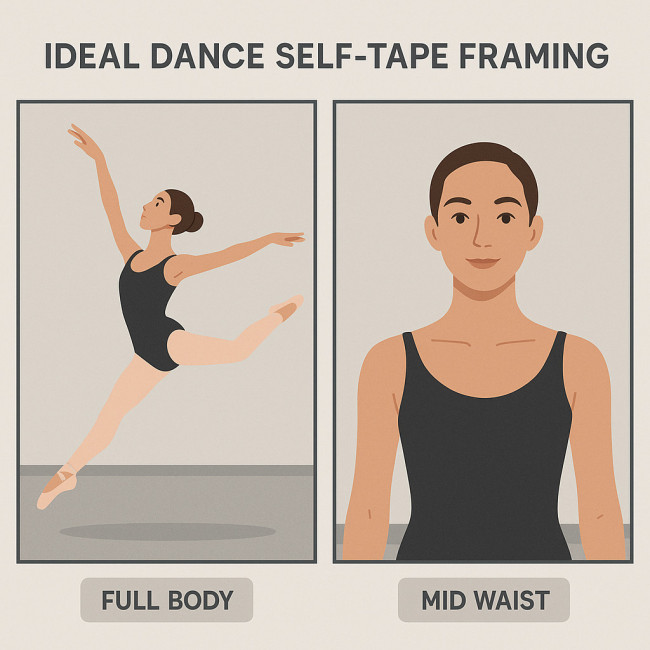
Keep head-to-toe coverage centred for leaps; crop to mid-waist up for subtle isolations or emotional beats. Maintaining a stable reference point helps AI motion-tracking tools assess balance and extension. For cutting a concise showcase of multiple styles, learn how a 30-second sizzle cut persuades directors who skim hundreds of tapes.
Common mistakes that kill callbacks
- Rolling shutter wobble: Fast pirouettes recorded on phones without stabilization look distorted.
- Over-compression: WhatsApp or Instagram re-exports introduce blocky shadows that mask foot placement.
- Room echo: Hardwood floors amplify reverb; add a rug beneath camera to dampen.
- Harsh overhead lighting: It flattens jumps, making hang-time appear shorter.
Curious about recruiter evaluation metrics? Discover what casting teams watch first to cut through the noise.
Workflow checklist: from rehearsal to upload
- Confirm brief: duration, style, orientation (portrait vs. landscape).
- Rehearse with camera locked to verify framing.
- Record slate in same setup—one continuous take saves editors' time.
- Backup to external drive immediately.
- Edit: trim dead air, normalise audio, add captions.
- Export with target specs from the table above.
- Run a 30-second quality check on desktop and mobile.
- Upload and submit link with file name in email subject line.
Ready for immersive showcases?
Some producers now request 360° or volumetric files. If you're upgrading, review AR-ready clips that keep you future-proof.
Stay visible beyond the file upload
After submitting, update your profile on the global dancer directory. Uploading the same polished take there multiplies reach and feeds algorithms that suggest talent to choreographers worldwide.
Quick self-tape quiz
FAQ
- What resolution should I use for a 2025 dance self-tape?
- Shoot in 4K (3840×2160) when possible; at minimum deliver 1080p to avoid automatic down-ranking by casting software.
- How long can my self-tape be?
- Keep each combo or variation under 60 seconds and total runtime under three minutes unless the brief states otherwise.
- Is smartphone footage acceptable?
- Yes—modern phones record excellent 4K, but stabilise with a tripod, add external audio and lock exposure to meet pro specs.
- How should I label the file?
- Use YEAR_ROLE_Name_Slate.mov to ensure instant identification in bulk folders.
Take action
Block one afternoon this week to audit your gear and export settings. Record a fresh combo, hit the spec checklist, upload to your Artfolio profile, and watch your next audition invite land faster.

